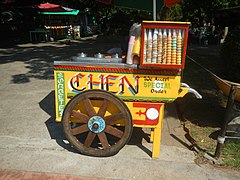Sorbetes
Cheese (queso) and chocolate sorbetes Bottom: Traditional sorbetero pushcart | |
| Type | Ice cream |
|---|---|
| Place of origin | Philippines |
| Serving temperature | Cold |
Sorbetes is a traditional
History and formulation
Ice was first introduced as a luxury item to the Philippines in 1847, when an American company, Russell & Sturgis, imported 250 tons of organic ice into the then Spanish colony. They acquired the tax-free rights to import ice into the Philippines by Royal Order in 1848. The company built the first
The first large-scale ice plant, the
The first sorbetes was made during this period using a primitive ice cream maker called a garapiñera. It consisted of a metal cylinder filled with the ice cream ingredients, enclosed by a wooden bucket filled with ice. It had a cranking mechanism that churned the contents of the cylinder until it acquired the texture and consistency of sorbetes. This typically took hours, and salt was added to the ingredients to speed up the freezing. These were sold on the streets by peddlers known as sorbeteros. They were originally on foot with a carrying pole (similar to taho vendors). Sorbeteros eventually started selling their products on a distinctive cart, which were gaudily decorated like jeepneys. Sorbeteros also carry a distinctive bell, that they intermittently rang. Each cart typically has three flavors, each dyed a vibrant color.[6]
Originally, sorbetes used cow's milk like American ice cream. Manufacturers eventually switched to the more readily available
Over time, sorbetes manufacturers also started competing with commercially available ice creams by adopting their flavors, like
Sorbetes acquired the name "dirty ice cream" as a joke, due to the fact that it is sold on the streets.[5][8]
Sorbetero

Sorbetes are peddled by sorbeteros (ice cream vendors)
The wooden cart has two large wooden wheels at the front part to easily push the cart though latest carts are already attached to
The Sorbetero has also been depicted in film and in song such as the 1979 film Mamang Sorbetero, and the song "Mamang Sorbetero", performed by Celeste Legaspi.[12]
Gallery
-
A woman purchasing strawberry sorbetes from a street vendor in La Trinidad, Benguet
-
Traditional colorful wooden sorbetes pushcart in Rizal Park, Manila
-
Children buying sorbetes in Baguio
-
Sorbetero serving sorbetes in the Malolos Historic Town Center, Bulacan
See also
- Sili ice cream
- Ube ice cream
- Queso ice cream
- Halo-halo
- Ice buko
- Ice scramble
- List of Philippine desserts
- Saba con hielo
References
- ^ "Filipino Dirty Ice Cream is Central London's Hottest Treat". Embassy of the Philippines, London. Republic of the Philippines. Archived from the original on August 8, 2022. Retrieved July 17, 2021.
- ^ "Home-Based Food Business Idea: Recipe for Sorbetes". Business News Philippines. Retrieved July 17, 2021.
- ^ "Gen Z calls out Tiktoker for captioning dirty ice cream, well, dirty ice cream". Manila Bulletin. May 20, 2021. Retrieved July 20, 2021.
- ^ ISBN 978-3-319-60824-2. Retrieved July 21, 2021.
- ^ a b c d e Bacsa, Camille (May 15, 2018). "The Food Story: Pinoy Sorbetes". BiteSized.ph. Retrieved November 10, 2022.
- ^ Diana Galang. "Sorbetes And The Philippine Dessert Repertoire". Manila Bulletin via mb.com.ph.
- ^ a b Mishell M. Malabaguio. "How To Make Sorbetes (Home-made Ice Cream)". www.entrepreneur.com.ph. Archived from the original on June 19, 2009. Retrieved July 16, 2009.
- ^ a b "Sorbetes". TasteAtlas. Retrieved November 10, 2022.
- ISBN 978-621-420-087-0. Retrieved July 20, 2021.
- ^ Sotelo, Yolanda (June 30, 2012). "Not-so-'dirty' ice cream brings in clean profit". Retrieved July 20, 2021.
- ^ "Why do they use salt to melt ice on the road in the winter?". HowStuffWorks.com. February 2, 2021.
- ^ Gabinete, Jojo (February 10, 2021). "Trailer ng Tililing, sagana sa malulutong na mura, maseselang lengguwahe". PEP.ph. Retrieved July 20, 2021.






